Managing People in Health and Social Care: Qualifi Level 4 Diploma
VerifiedAdded on 2023/01/06
|11
|2748
|88
Report
AI Summary
This report delves into the critical aspects of managing people within health and social care organizations. It begins by examining the factors involved in recruitment planning, differentiating between internal and external factors, and analyzing the impact of legislation and policy on the recruitment process. The report then explores different types of teams found in these settings, such as permanent and temporary teams (specialist, task force, advisory, and virtual teams), and discusses the process of team development using Tuckman’s model (forming, storming, norming, and performing). The role of appraisal in developing team members is also analyzed. Furthermore, the report identifies factors that drive change in health and social care organizations, including external pressures (economic factors, technology) and internal factors (HR policies, structural changes, and business strategy). It analyzes two models of change, including the Diffusion of Innovation model and Kurt Lewin's change management model, and examines potential barriers to change, such as communication issues. Overall, the report provides a comprehensive overview of human resource management principles within the context of health and social care.

MANAGING PEOPLE IN HEALTH
AND SOCIAL CARE
AND SOCIAL CARE
Secure Best Marks with AI Grader
Need help grading? Try our AI Grader for instant feedback on your assignments.
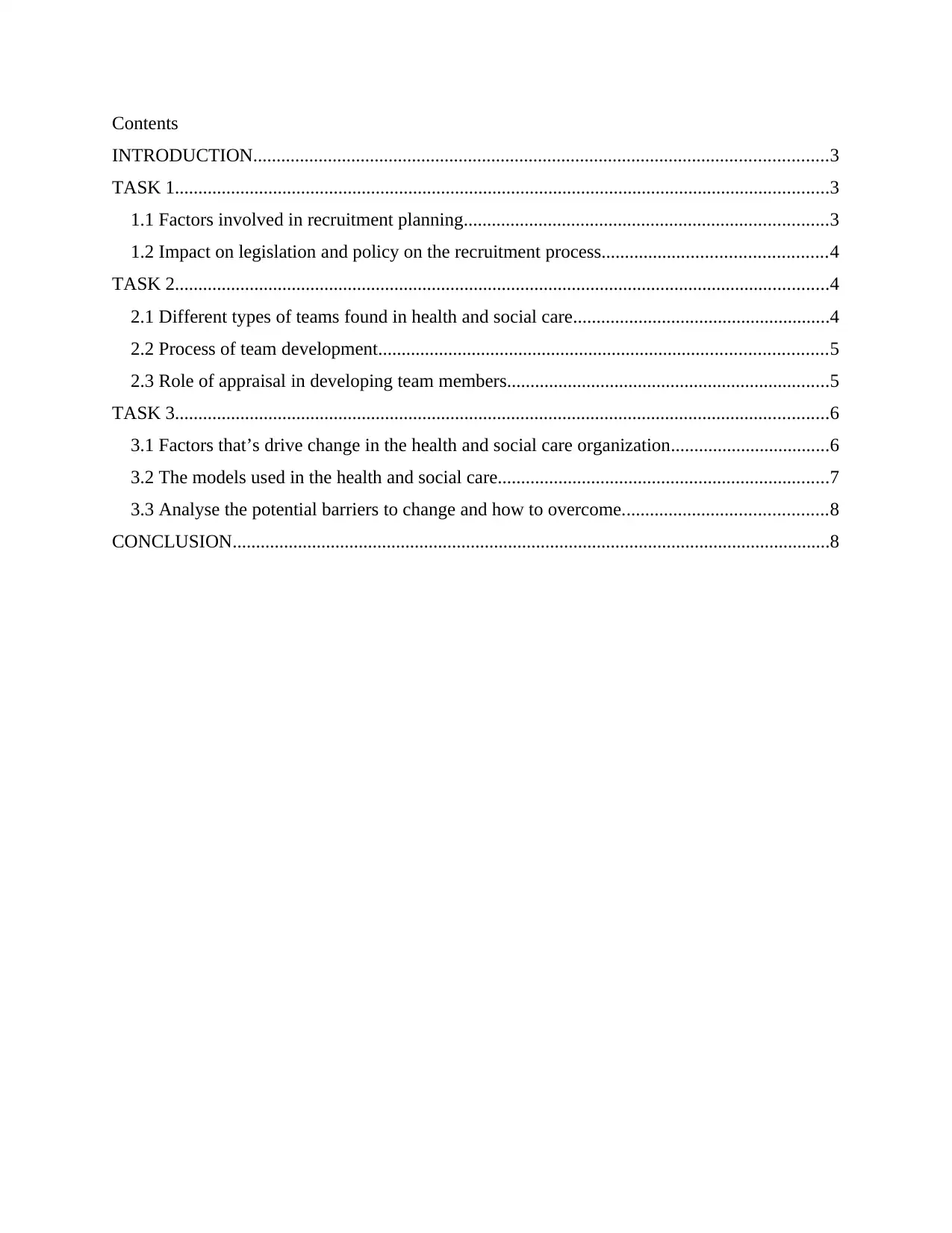
Contents
INTRODUCTION...........................................................................................................................3
TASK 1............................................................................................................................................3
1.1 Factors involved in recruitment planning..............................................................................3
1.2 Impact on legislation and policy on the recruitment process................................................4
TASK 2............................................................................................................................................4
2.1 Different types of teams found in health and social care.......................................................4
2.2 Process of team development................................................................................................5
2.3 Role of appraisal in developing team members.....................................................................5
TASK 3............................................................................................................................................6
3.1 Factors that’s drive change in the health and social care organization..................................6
3.2 The models used in the health and social care.......................................................................7
3.3 Analyse the potential barriers to change and how to overcome............................................8
CONCLUSION................................................................................................................................8
INTRODUCTION...........................................................................................................................3
TASK 1............................................................................................................................................3
1.1 Factors involved in recruitment planning..............................................................................3
1.2 Impact on legislation and policy on the recruitment process................................................4
TASK 2............................................................................................................................................4
2.1 Different types of teams found in health and social care.......................................................4
2.2 Process of team development................................................................................................5
2.3 Role of appraisal in developing team members.....................................................................5
TASK 3............................................................................................................................................6
3.1 Factors that’s drive change in the health and social care organization..................................6
3.2 The models used in the health and social care.......................................................................7
3.3 Analyse the potential barriers to change and how to overcome............................................8
CONCLUSION................................................................................................................................8
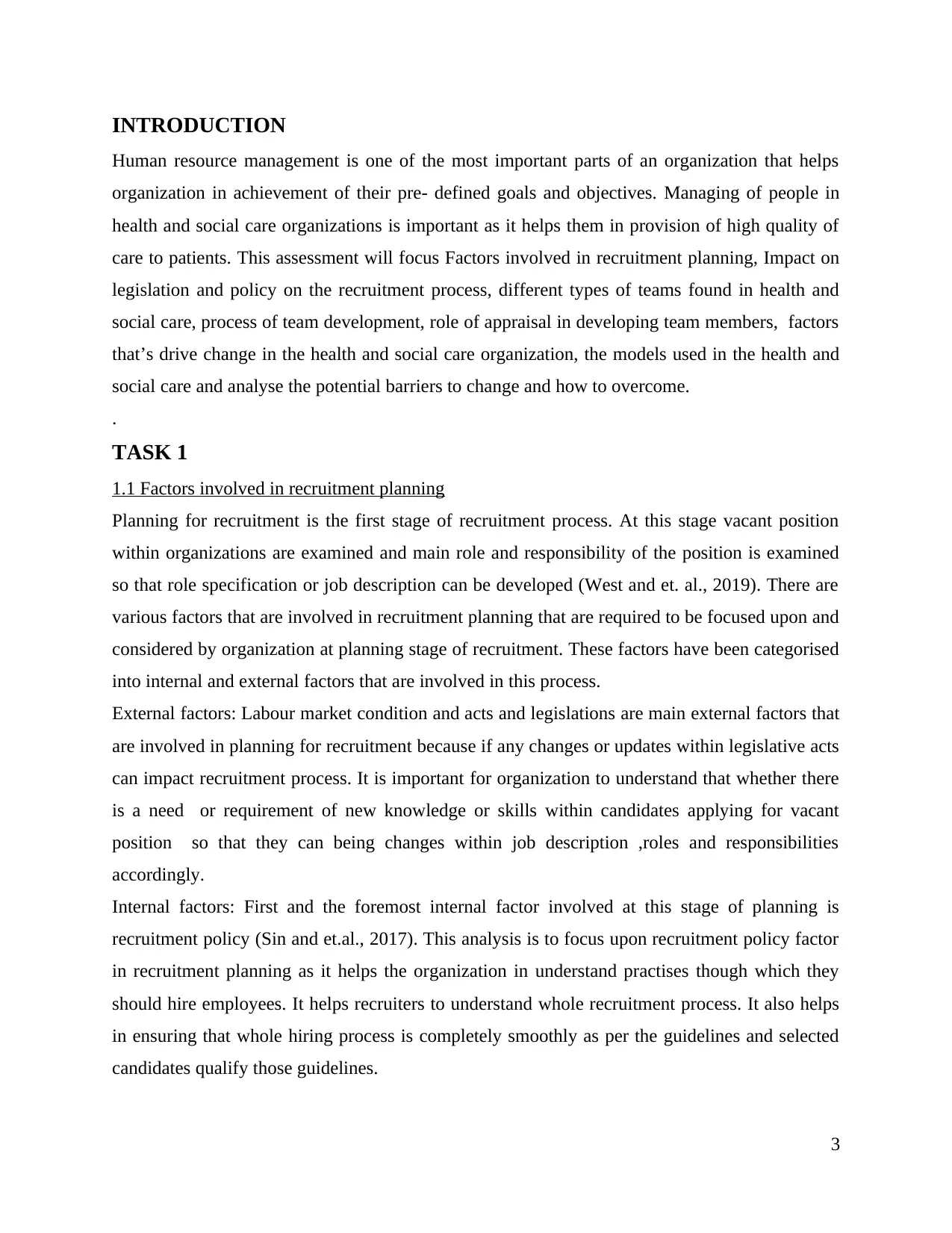
INTRODUCTION
Human resource management is one of the most important parts of an organization that helps
organization in achievement of their pre- defined goals and objectives. Managing of people in
health and social care organizations is important as it helps them in provision of high quality of
care to patients. This assessment will focus Factors involved in recruitment planning, Impact on
legislation and policy on the recruitment process, different types of teams found in health and
social care, process of team development, role of appraisal in developing team members, factors
that’s drive change in the health and social care organization, the models used in the health and
social care and analyse the potential barriers to change and how to overcome.
.
TASK 1
1.1 Factors involved in recruitment planning
Planning for recruitment is the first stage of recruitment process. At this stage vacant position
within organizations are examined and main role and responsibility of the position is examined
so that role specification or job description can be developed (West and et. al., 2019). There are
various factors that are involved in recruitment planning that are required to be focused upon and
considered by organization at planning stage of recruitment. These factors have been categorised
into internal and external factors that are involved in this process.
External factors: Labour market condition and acts and legislations are main external factors that
are involved in planning for recruitment because if any changes or updates within legislative acts
can impact recruitment process. It is important for organization to understand that whether there
is a need or requirement of new knowledge or skills within candidates applying for vacant
position so that they can being changes within job description ,roles and responsibilities
accordingly.
Internal factors: First and the foremost internal factor involved at this stage of planning is
recruitment policy (Sin and et.al., 2017). This analysis is to focus upon recruitment policy factor
in recruitment planning as it helps the organization in understand practises though which they
should hire employees. It helps recruiters to understand whole recruitment process. It also helps
in ensuring that whole hiring process is completely smoothly as per the guidelines and selected
candidates qualify those guidelines.
3
Human resource management is one of the most important parts of an organization that helps
organization in achievement of their pre- defined goals and objectives. Managing of people in
health and social care organizations is important as it helps them in provision of high quality of
care to patients. This assessment will focus Factors involved in recruitment planning, Impact on
legislation and policy on the recruitment process, different types of teams found in health and
social care, process of team development, role of appraisal in developing team members, factors
that’s drive change in the health and social care organization, the models used in the health and
social care and analyse the potential barriers to change and how to overcome.
.
TASK 1
1.1 Factors involved in recruitment planning
Planning for recruitment is the first stage of recruitment process. At this stage vacant position
within organizations are examined and main role and responsibility of the position is examined
so that role specification or job description can be developed (West and et. al., 2019). There are
various factors that are involved in recruitment planning that are required to be focused upon and
considered by organization at planning stage of recruitment. These factors have been categorised
into internal and external factors that are involved in this process.
External factors: Labour market condition and acts and legislations are main external factors that
are involved in planning for recruitment because if any changes or updates within legislative acts
can impact recruitment process. It is important for organization to understand that whether there
is a need or requirement of new knowledge or skills within candidates applying for vacant
position so that they can being changes within job description ,roles and responsibilities
accordingly.
Internal factors: First and the foremost internal factor involved at this stage of planning is
recruitment policy (Sin and et.al., 2017). This analysis is to focus upon recruitment policy factor
in recruitment planning as it helps the organization in understand practises though which they
should hire employees. It helps recruiters to understand whole recruitment process. It also helps
in ensuring that whole hiring process is completely smoothly as per the guidelines and selected
candidates qualify those guidelines.
3
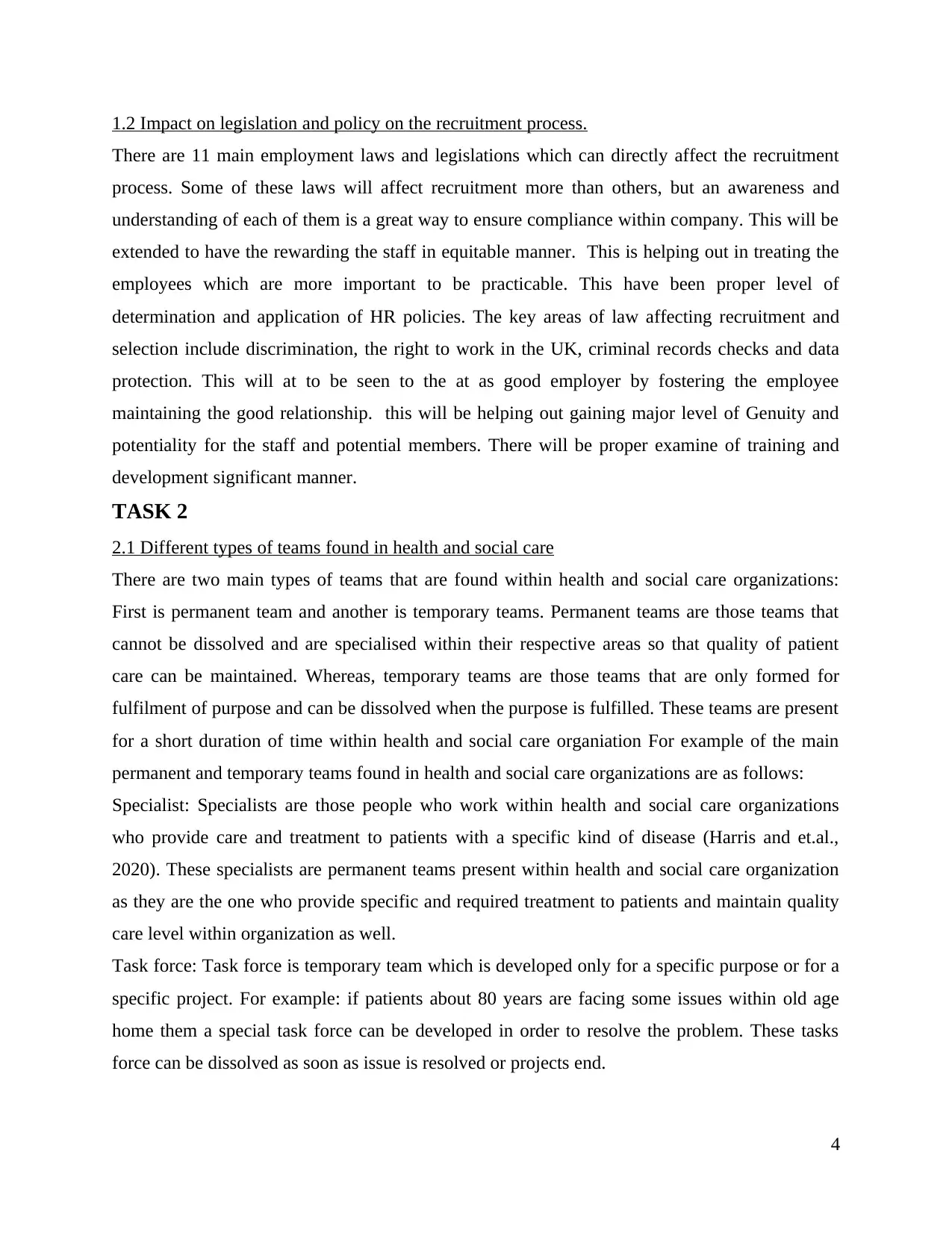
1.2 Impact on legislation and policy on the recruitment process.
There are 11 main employment laws and legislations which can directly affect the recruitment
process. Some of these laws will affect recruitment more than others, but an awareness and
understanding of each of them is a great way to ensure compliance within company. This will be
extended to have the rewarding the staff in equitable manner. This is helping out in treating the
employees which are more important to be practicable. This have been proper level of
determination and application of HR policies. The key areas of law affecting recruitment and
selection include discrimination, the right to work in the UK, criminal records checks and data
protection. This will at to be seen to the at as good employer by fostering the employee
maintaining the good relationship. this will be helping out gaining major level of Genuity and
potentiality for the staff and potential members. There will be proper examine of training and
development significant manner.
TASK 2
2.1 Different types of teams found in health and social care
There are two main types of teams that are found within health and social care organizations:
First is permanent team and another is temporary teams. Permanent teams are those teams that
cannot be dissolved and are specialised within their respective areas so that quality of patient
care can be maintained. Whereas, temporary teams are those teams that are only formed for
fulfilment of purpose and can be dissolved when the purpose is fulfilled. These teams are present
for a short duration of time within health and social care organiation For example of the main
permanent and temporary teams found in health and social care organizations are as follows:
Specialist: Specialists are those people who work within health and social care organizations
who provide care and treatment to patients with a specific kind of disease (Harris and et.al.,
2020). These specialists are permanent teams present within health and social care organization
as they are the one who provide specific and required treatment to patients and maintain quality
care level within organization as well.
Task force: Task force is temporary team which is developed only for a specific purpose or for a
specific project. For example: if patients about 80 years are facing some issues within old age
home them a special task force can be developed in order to resolve the problem. These tasks
force can be dissolved as soon as issue is resolved or projects end.
4
There are 11 main employment laws and legislations which can directly affect the recruitment
process. Some of these laws will affect recruitment more than others, but an awareness and
understanding of each of them is a great way to ensure compliance within company. This will be
extended to have the rewarding the staff in equitable manner. This is helping out in treating the
employees which are more important to be practicable. This have been proper level of
determination and application of HR policies. The key areas of law affecting recruitment and
selection include discrimination, the right to work in the UK, criminal records checks and data
protection. This will at to be seen to the at as good employer by fostering the employee
maintaining the good relationship. this will be helping out gaining major level of Genuity and
potentiality for the staff and potential members. There will be proper examine of training and
development significant manner.
TASK 2
2.1 Different types of teams found in health and social care
There are two main types of teams that are found within health and social care organizations:
First is permanent team and another is temporary teams. Permanent teams are those teams that
cannot be dissolved and are specialised within their respective areas so that quality of patient
care can be maintained. Whereas, temporary teams are those teams that are only formed for
fulfilment of purpose and can be dissolved when the purpose is fulfilled. These teams are present
for a short duration of time within health and social care organiation For example of the main
permanent and temporary teams found in health and social care organizations are as follows:
Specialist: Specialists are those people who work within health and social care organizations
who provide care and treatment to patients with a specific kind of disease (Harris and et.al.,
2020). These specialists are permanent teams present within health and social care organization
as they are the one who provide specific and required treatment to patients and maintain quality
care level within organization as well.
Task force: Task force is temporary team which is developed only for a specific purpose or for a
specific project. For example: if patients about 80 years are facing some issues within old age
home them a special task force can be developed in order to resolve the problem. These tasks
force can be dissolved as soon as issue is resolved or projects end.
4
Secure Best Marks with AI Grader
Need help grading? Try our AI Grader for instant feedback on your assignments.
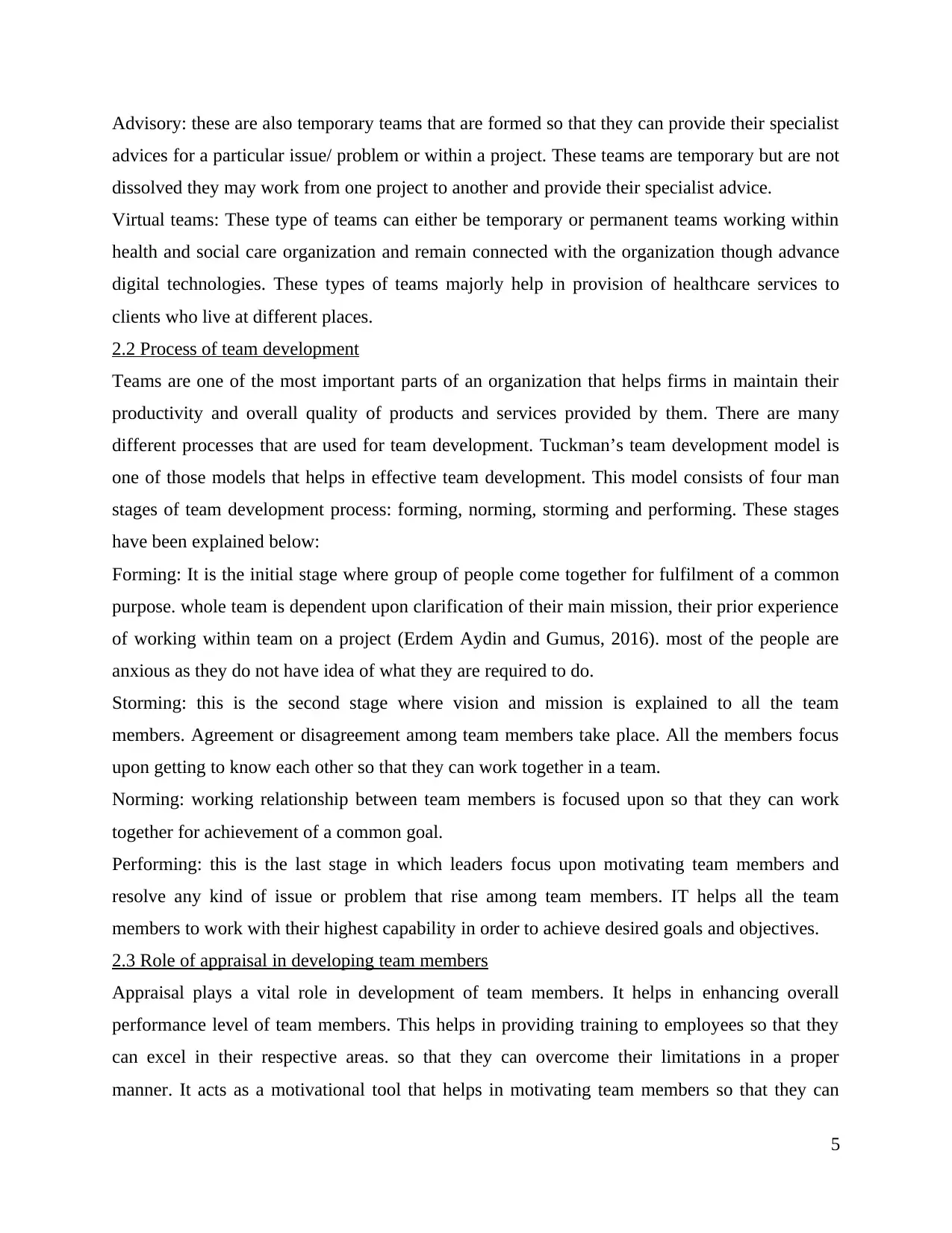
Advisory: these are also temporary teams that are formed so that they can provide their specialist
advices for a particular issue/ problem or within a project. These teams are temporary but are not
dissolved they may work from one project to another and provide their specialist advice.
Virtual teams: These type of teams can either be temporary or permanent teams working within
health and social care organization and remain connected with the organization though advance
digital technologies. These types of teams majorly help in provision of healthcare services to
clients who live at different places.
2.2 Process of team development
Teams are one of the most important parts of an organization that helps firms in maintain their
productivity and overall quality of products and services provided by them. There are many
different processes that are used for team development. Tuckman’s team development model is
one of those models that helps in effective team development. This model consists of four man
stages of team development process: forming, norming, storming and performing. These stages
have been explained below:
Forming: It is the initial stage where group of people come together for fulfilment of a common
purpose. whole team is dependent upon clarification of their main mission, their prior experience
of working within team on a project (Erdem Aydin and Gumus, 2016). most of the people are
anxious as they do not have idea of what they are required to do.
Storming: this is the second stage where vision and mission is explained to all the team
members. Agreement or disagreement among team members take place. All the members focus
upon getting to know each other so that they can work together in a team.
Norming: working relationship between team members is focused upon so that they can work
together for achievement of a common goal.
Performing: this is the last stage in which leaders focus upon motivating team members and
resolve any kind of issue or problem that rise among team members. IT helps all the team
members to work with their highest capability in order to achieve desired goals and objectives.
2.3 Role of appraisal in developing team members
Appraisal plays a vital role in development of team members. It helps in enhancing overall
performance level of team members. This helps in providing training to employees so that they
can excel in their respective areas. so that they can overcome their limitations in a proper
manner. It acts as a motivational tool that helps in motivating team members so that they can
5
advices for a particular issue/ problem or within a project. These teams are temporary but are not
dissolved they may work from one project to another and provide their specialist advice.
Virtual teams: These type of teams can either be temporary or permanent teams working within
health and social care organization and remain connected with the organization though advance
digital technologies. These types of teams majorly help in provision of healthcare services to
clients who live at different places.
2.2 Process of team development
Teams are one of the most important parts of an organization that helps firms in maintain their
productivity and overall quality of products and services provided by them. There are many
different processes that are used for team development. Tuckman’s team development model is
one of those models that helps in effective team development. This model consists of four man
stages of team development process: forming, norming, storming and performing. These stages
have been explained below:
Forming: It is the initial stage where group of people come together for fulfilment of a common
purpose. whole team is dependent upon clarification of their main mission, their prior experience
of working within team on a project (Erdem Aydin and Gumus, 2016). most of the people are
anxious as they do not have idea of what they are required to do.
Storming: this is the second stage where vision and mission is explained to all the team
members. Agreement or disagreement among team members take place. All the members focus
upon getting to know each other so that they can work together in a team.
Norming: working relationship between team members is focused upon so that they can work
together for achievement of a common goal.
Performing: this is the last stage in which leaders focus upon motivating team members and
resolve any kind of issue or problem that rise among team members. IT helps all the team
members to work with their highest capability in order to achieve desired goals and objectives.
2.3 Role of appraisal in developing team members
Appraisal plays a vital role in development of team members. It helps in enhancing overall
performance level of team members. This helps in providing training to employees so that they
can excel in their respective areas. so that they can overcome their limitations in a proper
manner. It acts as a motivational tool that helps in motivating team members so that they can
5
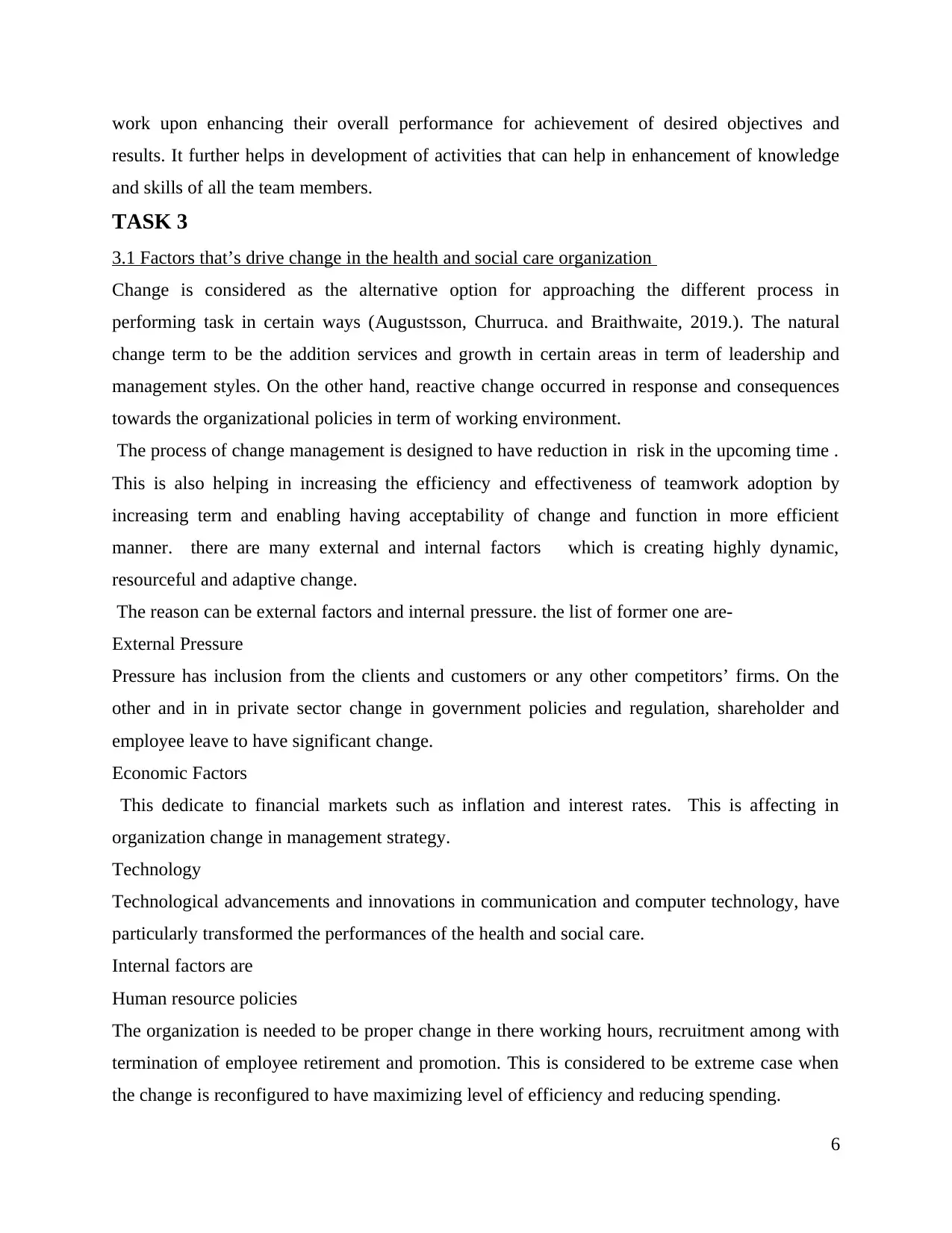
work upon enhancing their overall performance for achievement of desired objectives and
results. It further helps in development of activities that can help in enhancement of knowledge
and skills of all the team members.
TASK 3
3.1 Factors that’s drive change in the health and social care organization
Change is considered as the alternative option for approaching the different process in
performing task in certain ways (Augustsson, Churruca. and Braithwaite, 2019.). The natural
change term to be the addition services and growth in certain areas in term of leadership and
management styles. On the other hand, reactive change occurred in response and consequences
towards the organizational policies in term of working environment.
The process of change management is designed to have reduction in risk in the upcoming time .
This is also helping in increasing the efficiency and effectiveness of teamwork adoption by
increasing term and enabling having acceptability of change and function in more efficient
manner. there are many external and internal factors which is creating highly dynamic,
resourceful and adaptive change.
The reason can be external factors and internal pressure. the list of former one are-
External Pressure
Pressure has inclusion from the clients and customers or any other competitors’ firms. On the
other and in in private sector change in government policies and regulation, shareholder and
employee leave to have significant change.
Economic Factors
This dedicate to financial markets such as inflation and interest rates. This is affecting in
organization change in management strategy.
Technology
Technological advancements and innovations in communication and computer technology, have
particularly transformed the performances of the health and social care.
Internal factors are
Human resource policies
The organization is needed to be proper change in there working hours, recruitment among with
termination of employee retirement and promotion. This is considered to be extreme case when
the change is reconfigured to have maximizing level of efficiency and reducing spending.
6
results. It further helps in development of activities that can help in enhancement of knowledge
and skills of all the team members.
TASK 3
3.1 Factors that’s drive change in the health and social care organization
Change is considered as the alternative option for approaching the different process in
performing task in certain ways (Augustsson, Churruca. and Braithwaite, 2019.). The natural
change term to be the addition services and growth in certain areas in term of leadership and
management styles. On the other hand, reactive change occurred in response and consequences
towards the organizational policies in term of working environment.
The process of change management is designed to have reduction in risk in the upcoming time .
This is also helping in increasing the efficiency and effectiveness of teamwork adoption by
increasing term and enabling having acceptability of change and function in more efficient
manner. there are many external and internal factors which is creating highly dynamic,
resourceful and adaptive change.
The reason can be external factors and internal pressure. the list of former one are-
External Pressure
Pressure has inclusion from the clients and customers or any other competitors’ firms. On the
other and in in private sector change in government policies and regulation, shareholder and
employee leave to have significant change.
Economic Factors
This dedicate to financial markets such as inflation and interest rates. This is affecting in
organization change in management strategy.
Technology
Technological advancements and innovations in communication and computer technology, have
particularly transformed the performances of the health and social care.
Internal factors are
Human resource policies
The organization is needed to be proper change in there working hours, recruitment among with
termination of employee retirement and promotion. This is considered to be extreme case when
the change is reconfigured to have maximizing level of efficiency and reducing spending.
6
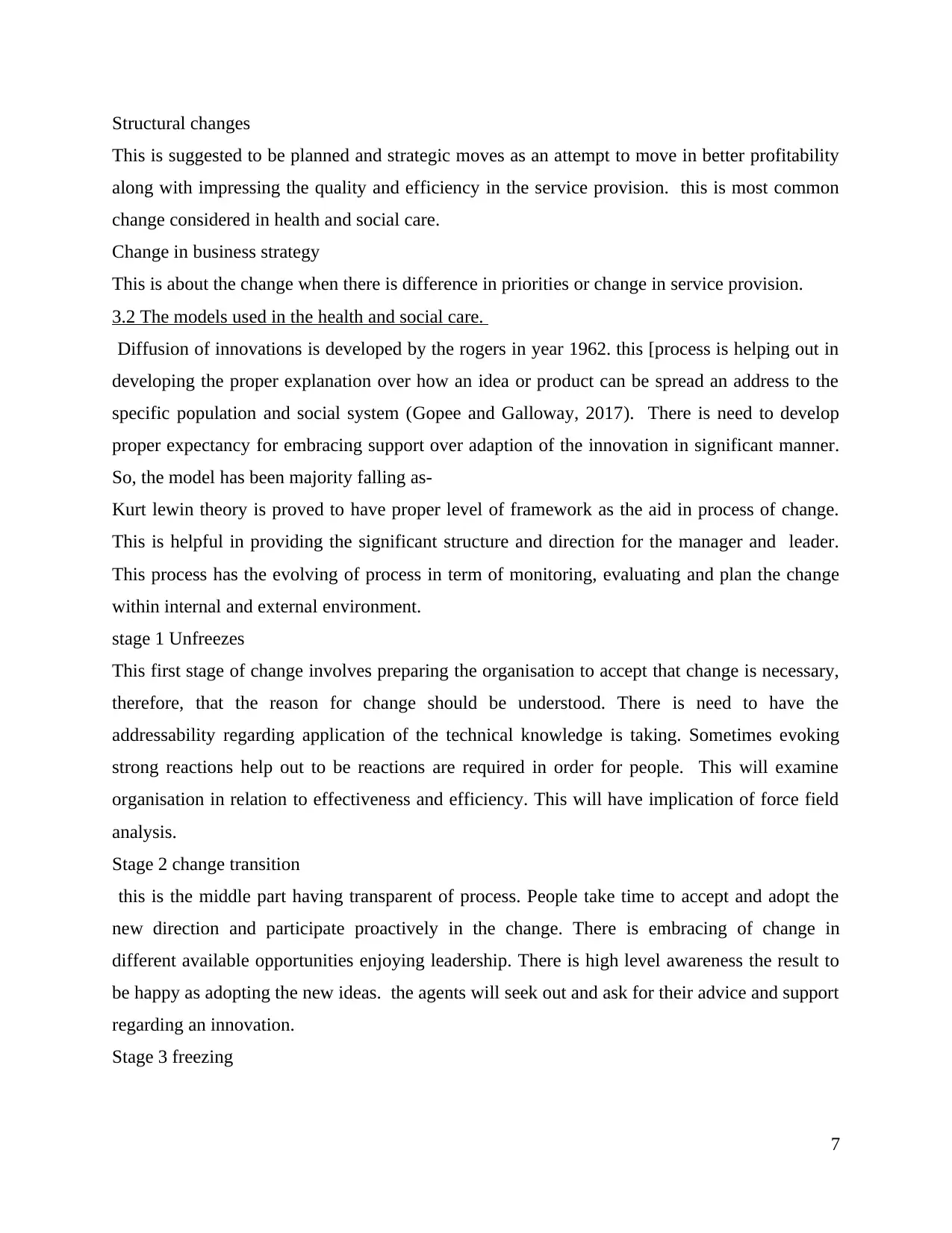
Structural changes
This is suggested to be planned and strategic moves as an attempt to move in better profitability
along with impressing the quality and efficiency in the service provision. this is most common
change considered in health and social care.
Change in business strategy
This is about the change when there is difference in priorities or change in service provision.
3.2 The models used in the health and social care.
Diffusion of innovations is developed by the rogers in year 1962. this [process is helping out in
developing the proper explanation over how an idea or product can be spread an address to the
specific population and social system (Gopee and Galloway, 2017). There is need to develop
proper expectancy for embracing support over adaption of the innovation in significant manner.
So, the model has been majority falling as-
Kurt lewin theory is proved to have proper level of framework as the aid in process of change.
This is helpful in providing the significant structure and direction for the manager and leader.
This process has the evolving of process in term of monitoring, evaluating and plan the change
within internal and external environment.
stage 1 Unfreezes
This first stage of change involves preparing the organisation to accept that change is necessary,
therefore, that the reason for change should be understood. There is need to have the
addressability regarding application of the technical knowledge is taking. Sometimes evoking
strong reactions help out to be reactions are required in order for people. This will examine
organisation in relation to effectiveness and efficiency. This will have implication of force field
analysis.
Stage 2 change transition
this is the middle part having transparent of process. People take time to accept and adopt the
new direction and participate proactively in the change. There is embracing of change in
different available opportunities enjoying leadership. There is high level awareness the result to
be happy as adopting the new ideas. the agents will seek out and ask for their advice and support
regarding an innovation.
Stage 3 freezing
7
This is suggested to be planned and strategic moves as an attempt to move in better profitability
along with impressing the quality and efficiency in the service provision. this is most common
change considered in health and social care.
Change in business strategy
This is about the change when there is difference in priorities or change in service provision.
3.2 The models used in the health and social care.
Diffusion of innovations is developed by the rogers in year 1962. this [process is helping out in
developing the proper explanation over how an idea or product can be spread an address to the
specific population and social system (Gopee and Galloway, 2017). There is need to develop
proper expectancy for embracing support over adaption of the innovation in significant manner.
So, the model has been majority falling as-
Kurt lewin theory is proved to have proper level of framework as the aid in process of change.
This is helpful in providing the significant structure and direction for the manager and leader.
This process has the evolving of process in term of monitoring, evaluating and plan the change
within internal and external environment.
stage 1 Unfreezes
This first stage of change involves preparing the organisation to accept that change is necessary,
therefore, that the reason for change should be understood. There is need to have the
addressability regarding application of the technical knowledge is taking. Sometimes evoking
strong reactions help out to be reactions are required in order for people. This will examine
organisation in relation to effectiveness and efficiency. This will have implication of force field
analysis.
Stage 2 change transition
this is the middle part having transparent of process. People take time to accept and adopt the
new direction and participate proactively in the change. There is embracing of change in
different available opportunities enjoying leadership. There is high level awareness the result to
be happy as adopting the new ideas. the agents will seek out and ask for their advice and support
regarding an innovation.
Stage 3 freezing
7
Paraphrase This Document
Need a fresh take? Get an instant paraphrase of this document with our AI Paraphraser
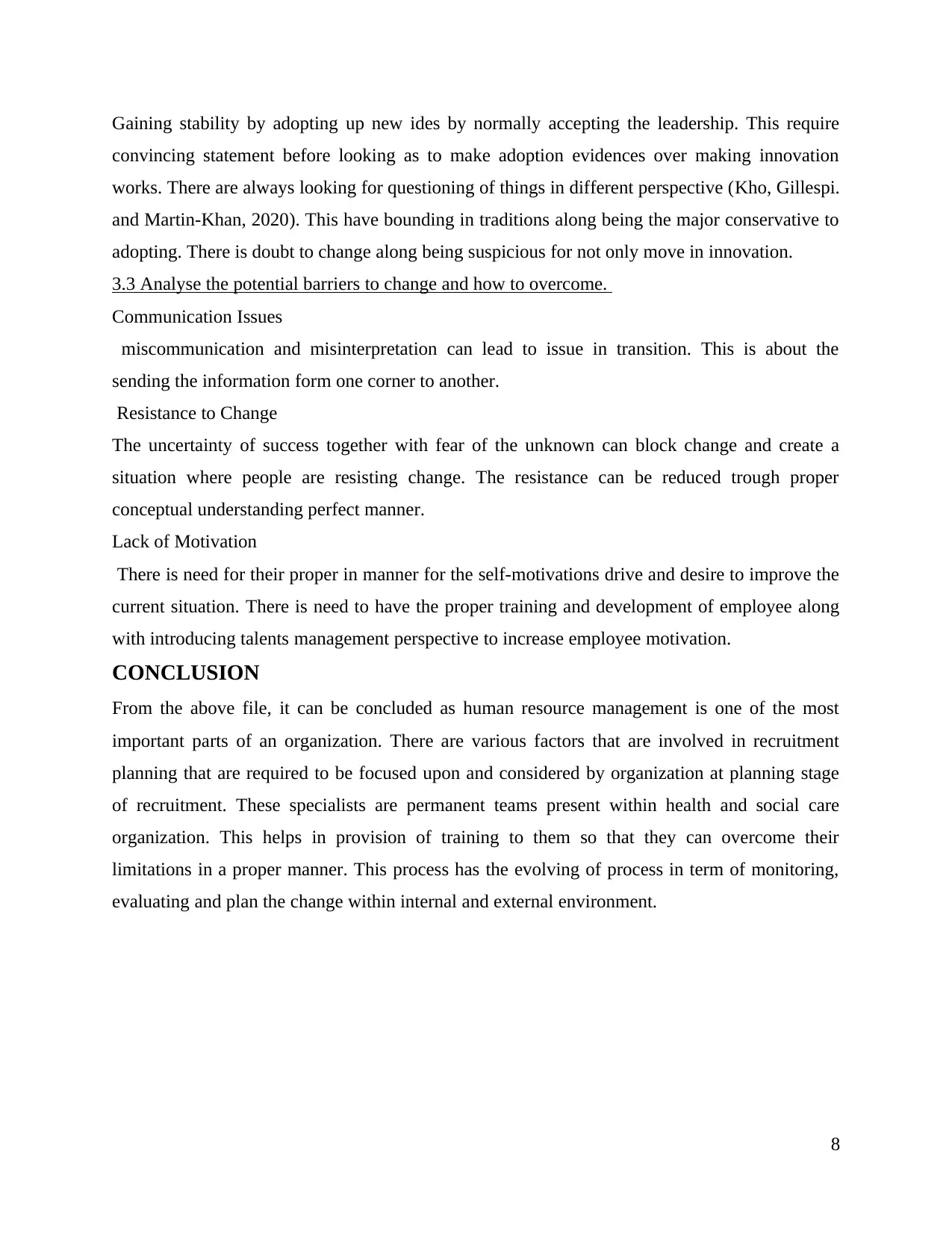
Gaining stability by adopting up new ides by normally accepting the leadership. This require
convincing statement before looking as to make adoption evidences over making innovation
works. There are always looking for questioning of things in different perspective (Kho, Gillespi.
and Martin-Khan, 2020). This have bounding in traditions along being the major conservative to
adopting. There is doubt to change along being suspicious for not only move in innovation.
3.3 Analyse the potential barriers to change and how to overcome.
Communication Issues
miscommunication and misinterpretation can lead to issue in transition. This is about the
sending the information form one corner to another.
Resistance to Change
The uncertainty of success together with fear of the unknown can block change and create a
situation where people are resisting change. The resistance can be reduced trough proper
conceptual understanding perfect manner.
Lack of Motivation
There is need for their proper in manner for the self-motivations drive and desire to improve the
current situation. There is need to have the proper training and development of employee along
with introducing talents management perspective to increase employee motivation.
CONCLUSION
From the above file, it can be concluded as human resource management is one of the most
important parts of an organization. There are various factors that are involved in recruitment
planning that are required to be focused upon and considered by organization at planning stage
of recruitment. These specialists are permanent teams present within health and social care
organization. This helps in provision of training to them so that they can overcome their
limitations in a proper manner. This process has the evolving of process in term of monitoring,
evaluating and plan the change within internal and external environment.
8
convincing statement before looking as to make adoption evidences over making innovation
works. There are always looking for questioning of things in different perspective (Kho, Gillespi.
and Martin-Khan, 2020). This have bounding in traditions along being the major conservative to
adopting. There is doubt to change along being suspicious for not only move in innovation.
3.3 Analyse the potential barriers to change and how to overcome.
Communication Issues
miscommunication and misinterpretation can lead to issue in transition. This is about the
sending the information form one corner to another.
Resistance to Change
The uncertainty of success together with fear of the unknown can block change and create a
situation where people are resisting change. The resistance can be reduced trough proper
conceptual understanding perfect manner.
Lack of Motivation
There is need for their proper in manner for the self-motivations drive and desire to improve the
current situation. There is need to have the proper training and development of employee along
with introducing talents management perspective to increase employee motivation.
CONCLUSION
From the above file, it can be concluded as human resource management is one of the most
important parts of an organization. There are various factors that are involved in recruitment
planning that are required to be focused upon and considered by organization at planning stage
of recruitment. These specialists are permanent teams present within health and social care
organization. This helps in provision of training to them so that they can overcome their
limitations in a proper manner. This process has the evolving of process in term of monitoring,
evaluating and plan the change within internal and external environment.
8
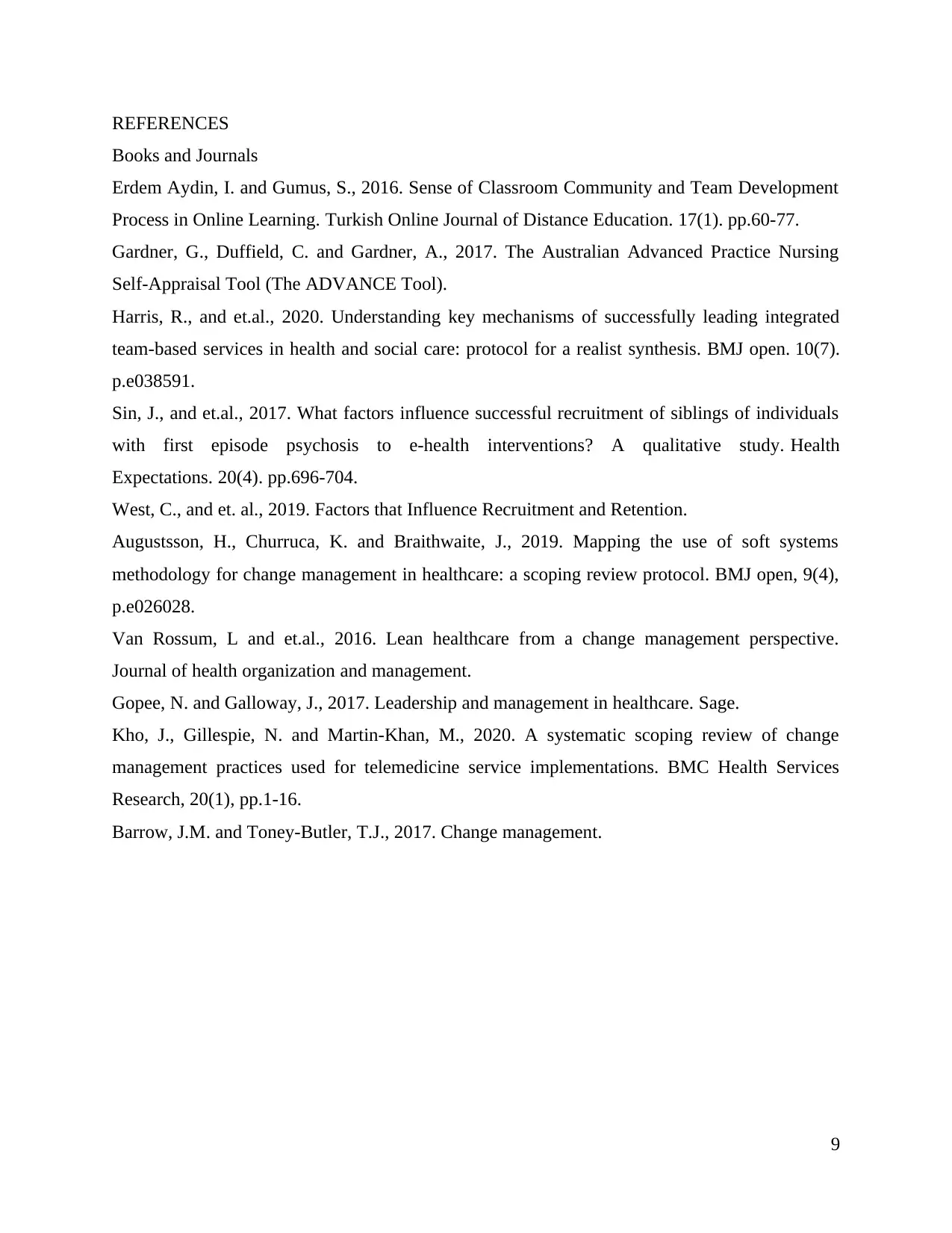
REFERENCES
Books and Journals
Erdem Aydin, I. and Gumus, S., 2016. Sense of Classroom Community and Team Development
Process in Online Learning. Turkish Online Journal of Distance Education. 17(1). pp.60-77.
Gardner, G., Duffield, C. and Gardner, A., 2017. The Australian Advanced Practice Nursing
Self-Appraisal Tool (The ADVANCE Tool).
Harris, R., and et.al., 2020. Understanding key mechanisms of successfully leading integrated
team-based services in health and social care: protocol for a realist synthesis. BMJ open. 10(7).
p.e038591.
Sin, J., and et.al., 2017. What factors influence successful recruitment of siblings of individuals
with first episode psychosis to e‐health interventions? A qualitative study. Health
Expectations. 20(4). pp.696-704.
West, C., and et. al., 2019. Factors that Influence Recruitment and Retention.
Augustsson, H., Churruca, K. and Braithwaite, J., 2019. Mapping the use of soft systems
methodology for change management in healthcare: a scoping review protocol. BMJ open, 9(4),
p.e026028.
Van Rossum, L and et.al., 2016. Lean healthcare from a change management perspective.
Journal of health organization and management.
Gopee, N. and Galloway, J., 2017. Leadership and management in healthcare. Sage.
Kho, J., Gillespie, N. and Martin-Khan, M., 2020. A systematic scoping review of change
management practices used for telemedicine service implementations. BMC Health Services
Research, 20(1), pp.1-16.
Barrow, J.M. and Toney-Butler, T.J., 2017. Change management.
9
Books and Journals
Erdem Aydin, I. and Gumus, S., 2016. Sense of Classroom Community and Team Development
Process in Online Learning. Turkish Online Journal of Distance Education. 17(1). pp.60-77.
Gardner, G., Duffield, C. and Gardner, A., 2017. The Australian Advanced Practice Nursing
Self-Appraisal Tool (The ADVANCE Tool).
Harris, R., and et.al., 2020. Understanding key mechanisms of successfully leading integrated
team-based services in health and social care: protocol for a realist synthesis. BMJ open. 10(7).
p.e038591.
Sin, J., and et.al., 2017. What factors influence successful recruitment of siblings of individuals
with first episode psychosis to e‐health interventions? A qualitative study. Health
Expectations. 20(4). pp.696-704.
West, C., and et. al., 2019. Factors that Influence Recruitment and Retention.
Augustsson, H., Churruca, K. and Braithwaite, J., 2019. Mapping the use of soft systems
methodology for change management in healthcare: a scoping review protocol. BMJ open, 9(4),
p.e026028.
Van Rossum, L and et.al., 2016. Lean healthcare from a change management perspective.
Journal of health organization and management.
Gopee, N. and Galloway, J., 2017. Leadership and management in healthcare. Sage.
Kho, J., Gillespie, N. and Martin-Khan, M., 2020. A systematic scoping review of change
management practices used for telemedicine service implementations. BMC Health Services
Research, 20(1), pp.1-16.
Barrow, J.M. and Toney-Butler, T.J., 2017. Change management.
9

10
Secure Best Marks with AI Grader
Need help grading? Try our AI Grader for instant feedback on your assignments.

11
1 out of 11
Related Documents
Your All-in-One AI-Powered Toolkit for Academic Success.
+13062052269
info@desklib.com
Available 24*7 on WhatsApp / Email
![[object Object]](/_next/static/media/star-bottom.7253800d.svg)
Unlock your academic potential
© 2024 | Zucol Services PVT LTD | All rights reserved.





